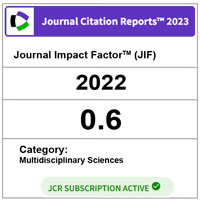Rainfall, evapotranspiration and rainfall deficit trend in Alor Setar, Malaysia
DOI:
https://doi.org/10.11113/mjfas.v13n4-1.844Keywords:
Rainfall, Potential evapotranspiration, Rainfall deficit, Penman-MonteithAbstract
Rainfall and potential evapotranspiration are important variables in water balance study. Rainfall data were obtained from Malaysian Meteorological Department while estimates of potential evapotranspiration were calculated using Penman-Monteith method. Trend analysis of monthly and annual rainfall, potential evapotranspiration and rainfall deficit are essential to manage irrigation system in agricultural systems. This is because changes in trend of these parameters may affect the water cycle and ecosystem. Annual and monthly values of these variables were analysed from 1980-2009. Results indicated increasing trends of 16.2 mm yr-1 and 3.01 mm yr-1 for both annual rainfall and potential evapotranspiration, respectively. Consequently, these trends resulted in annual rainfall deficit of 1.69 mm per year.
References
Allen, R. G., Pereira, L. S., Raes, D. and Smith, M. 1998. Crop evapotranspiration: Guidelines for computing crop water requirements. Irrigation and Drainage Paper No. 56. Food and Agriculture Organization of the United Nations, Rome, Italy. Retrieved from http://www.hidmet.gov.rs/podaci/agro/table%20of%20contens_files.pdf
Ali, M. H. and Shui, L. T. 2009. Potential evapotranspiration model for Muda irrigation project, Malaysia. Water Resource Management. 23, 57-69.
Antonia, L., Paolo, V. Trend analysis and seasonal rainfall time series in the Mediterranean area. 2009. International Journal of Climatology. 30(10), 1538-1546.
Gary, F., Stacy, C., Zaid, A., Daniel, K. F., Ying, O., Ardeshir, A. and Johnie, N. J. 2016. Trend analysis and forecast of precipitation, reference evapotranspiration and rainfall deficit in Blackland Prairie of Eastern Mississippi. Journal of Applied Meteorology and Climatology. 55, 1425-1439.
Ijaz, A., Deshan, T., Tian, F. W., Mei, W. and Bakhtawar, W. 2015. Precipitation trends over time using Mann-Kendall and Spearman’s rho tests in Swat River basin, Pakistan. Advance in Meteorology. 2015, 1-15.
Mohtar, Z. A., Yahaya, A. S., Ahmad, F., Suri, S., and Halim, M. H. 2014. Trends for daily rainfall in Northern and Southern region of Peninsular Malaysia. Journal of Civil Engineering Research. 4(3A), 222-227.
Smith, M., Allen, R. G., Monteith, J. L., Pereira, L. S. Perrier, A. and Pruitt, W. O. 1992. Report on the expert consultation on procedures for revision of FAO guidelines for prediction of crop water requirements. Land and Water Development Division, United Nations. Food and Agriculture Service, Rome, Italy.
Schulze,W., Dayan, P. and Read,. M. P. 1997. A neural substrate of prediction and reward. Science. 275(5306), 1593-1599.
Sen, P. K. Estimates of the regression coefficient based on Kendall’s tau. 1968. Journal of American Statistics Association. 63, 1379-1389.
Syafarina, A. H., Zalina, M. D. and Juneng, L. 2015. Historical trend of hourly extreme rainfall in Peninsular Malaysia. Theoretical and Applied Climatology. 1201(1-2), 259-285.
Thornthwaite, C. W. An approach toward a rational classification of climate.1948. Geographical Review. 38, 55-95.
Tukimat, N. N. A. and Harun, S. The projection of future rainfall change over Kedah, Malaysia with the statistical downscaling Model. Malaysian Journal of Civil Engineering. 2011. 23(2), 67-79.







